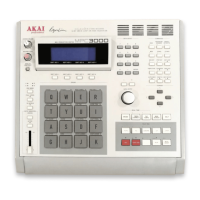Chapter 3: Recording Sequences
Page 69
• The Sig field (time signature):
This field shows the time signature entered in the previous screen.
It is for display only and cannot be changed.
• The Bars field
This shows the total number of bars in the newly initialized se-
quence, which is always initialized to 1 bar. When recording begins,
additional bars will be added to the end of the sequence as needed,
as is normal when the Loop field is set to OFF in the Play/Record
screen.
• The Loop field:
This is for display only and cannot be changed. It indicates that the
sequence’s Loop field is forced to OFF because loop recording is not
permitted during 16 channel recording.
• The <Done> soft key:
When finished recording, press this soft key to exit to the Play/
Record screen with your new sequence intact.
To record the incoming sequence:
While holding the RECORD key on the MPC3000, start the exter-
nal sequencer playing from the beginning of its sequence. As soon as
the MPC3000 receives the sync signals, it will enter Record mode
and begin recording the data from the other sequencer in real time.
(Note: The OVERDUB key is disabled during 16 channel recording.)
Once the transfer is finished, stop the external sequencer (the
MPC3000 will stop automatically) or manually stop the MPC3000.
The MPC3000 now contains the transferred sequence, which can be
played using the PLAY, PLAY START, REWIND, FAST FORWARD
and LOCATE keys. Play the sequence; if the transfer was success-
ful, press <Done> to return to the Play/Record screen. If the
transfer didn’t come out as intended, try again by holding RECORD
and starting the other sequencer.
COMMENT: If the incoming multitrack sequence contains a
large amount of data or is playing at a very fast tempo, it is
possible for the MPC3000 to become overloaded, causing
delays in the timing of the recorded sequence. If this occurs,
reduce the tempo of the sending sequencer. This will lower the
MPC3000’s processing requirement, and should eliminate
any overload errors.

